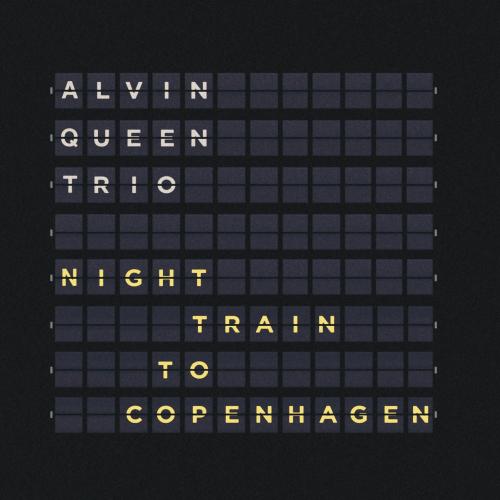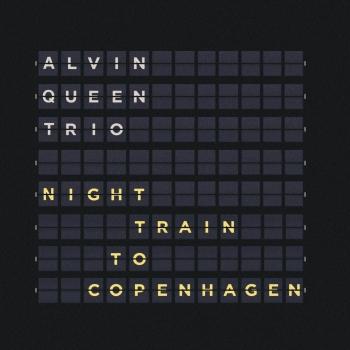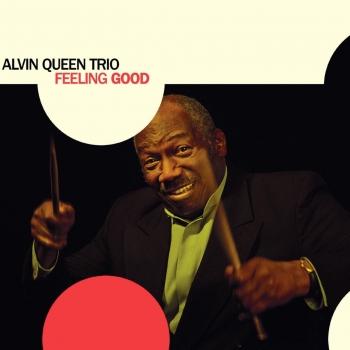
Night Train to Copenhagen Alvin Queen Trio
Album info
Album-Release:
2021
HRA-Release:
02.07.2021
Album including Album cover
- 1 Have You Met Miss Jones? 03:44
- 2 Bags Groove 03:31
- 3 I Got It Bad (And That Ain't Good) 04:16
- 4 Farewell Song 02:39
- 5 Quiet Nights Of Quiet Stars (Corcovado) 03:02
- 6 The Days Of Wine And Roses 02:39
- 7 Goodbye JD 03:33
- 8 Tranquility In The Woods (I skovens dybe stille ro) 02:19
- 9 D & E 03:15
- 10 Georgia On My Mind 04:48
- 11 Night Train 04:15
- 12 C Jam Blues 03:06
- 13 People 03:42
- 14 Moten Swing 03:46
- 15 Some Other Time 03:45
Info for Night Train to Copenhagen
The Alvin Queen Trio's new album "Night Train To Copenhagen" featuring new renditions of songs from the classic Oscar Peterson records "Night Train" and "We Get Requests" will officially be released by Stunt Records.
The studio album “Night Train” by the Oscar Peterson Trio was released in 1963 and featured pianist Oscar Peterson in his classic trio with Ray Brown on bass and Ed Thigpen on drums. It is arguably the most successful, popular and acclaimed album of Peterson’s life and career. The recording sessions took place December 15 & 16, 1962 in Los Angeles under Norman Granz’ supervision. The Penguin Guide to Jazz describes it as "one of the best LPs of the period.” The album was named as the jury winner of the Polaris Heritage Prize in 2019 and Diana Krall reported that listening to the album sparked her ambition of becoming a jazz pianist. Tonight’s leader, Alvin Queen, is a legend in his own right. For many years, he was the drummer in Oscar Peterson’s final group before the latter’s passing in 2007.
Alvin Queen Trio:
Calle Brickman, piano
Tobias Dall, double bass
Alvin Queen, drums
Alvin Queen
was born on August 16, 1950, in the Bronx, New York, but his family relocated to Mt. Vernon when he was 2 years old. The Queens were poor, but the Levister Towers Projects, where Alvin grew up, proved to be rich territory, as he was surrounded by many individuals who, like him, sprouted into the leading exponents of their generation.
There were scores of musicians, like sax men John Purcell and Jimmy Hill; vibraphonist Jay Hoggard; pianist Tommy James; B-3 organ champ Richard Levister; his swinging brother, Millard Levister on drums; and far too many others to name. And Alvin's list of celebrity running mates didn't end with musicians; they included future NBA stars like Ray Williams of the New York Knicks and Gus Williams of the Seattle Supersonics.
Alvin's hoop skills, however, were limited to the neighborhood courts, where he'd go head-to-head at the infamous Fourth Street playground with other wannabe hardwood stars, which included future Academy Award winner Denzel Washington. In fact, it was Denzel's father, Elder D. Washington Sr., who was pastor of the First Church of God In Christ, where Alvin's grandmother was a member. That church ended up playing a pivotal role in Alvin's life, because it's where he got his first dose of spirit-filled music, and -- after he began singing in the choir and playing the tambourine - it's where he began connecting with and conveying the rhythms of his life.
Alvin was introduced to the drums at an early age by his brother, Willie Queen, who was a standout percussionist at with the Grime School Marching Band. It was Willie who convinced Alvin that this was something he should stick with. While Christmas shopping with his mother one morning, Alvin spotted a kid playing drums in the second-floor storefront window of the Andy Lalino Drum Studio. At the time, Alvin had been earning some change shining shoes, but dreams of pulling together enough money to get his own drum set were just that - dreams.
But while shining shoes wouldn't get him the money he needed, it did give him an excuse to meet the studio owner. So one day, Alvin, shoe shine kit in hand, wandered up the stairs of the studio and asked Andy Lalino if he wanted a shine.
That’s how it all began. “You know anything about playing drums?” Andy asked.
“Well, I play for the Grime School Marching Band, and I’d love to play your drum set,” Alvin replied.
“OK, then have your mother give me a call,” he said.
Alvin’s mother contacted Lalino and Alvin started lessons. But money was tight, and the lessons were one of the first things that had to go.
Fortunately, though, Andy decided to keep Alvin around the studio for odd jobs and an occasional shine.
Free lessons were a bonus.
Alvin was introduced to jazz at an early age. Every Saturday, his father would take him to Harlem to have his hair done at Sugar Ray Robinson’s barbershop. Afterward, he’d take Alvin to the Apollo to catch a show before heading back to Mount Vernon. He’d see such lions as John Coltrane; the Cannonball Adderley Quintet, featuring Nancy Wilson; and Ruth Brown, who would end up giving Alvin one of his first professional gigs.
During the early ’60s, there were many places to check out jazz in Mount Vernon, too. The city might have been only four square miles, but there were at least eight clubs in the tiny town.
In fact, it was in Mount Vernon that Alvin played his first date. It was at a club called the Ambassador Lounge, with the Jimmy Hill Trio, featuring Richard Levister.
The drummer couldn’t make the date at the last minute, and Jimmy Hill came to Alvin’s parents’ home to see if Alvin could help out. Alvin was just 11 years old, and the only way he could get in was to be escorted by an adult. But Alvin knew all the tunes, thanks to his father’s record collection, and the word was out that he was “the man,” despite his young age.
“This is how my professional music career started,” Alvin says, “Thanks once again to people like Jimmy Hill and Tina Sattin, who helped out so many kids in the Westchester area, working with us through the YTI in Yonkers, to keep us on the right track.”
That same year, it was Andy Lalino who escorted Alvin to the original Birdland on 52nd street for the annual Gretsch Drum Night.
Andy seated his student right next to an all-star lineup of drummers: Art Blakey, Elvin Jones, Mel Lewis, Charlie Persip and Max Roach. And after Alvin played, they all poured accolades on the young prodigy for his performance.
A year later, Alvin did his first recording at the age of 12, but the recording was never released. Joe Newman was the contractor and musical director; the musicians included Joe Newman on trumpet; Zoot Sims on tenor sax; Art Davis on bass; Hank Jones on piano, on only one side; and Harold Mabern, playing piano on the other side.
Despite the whirlwind of musical opportunities that had come Alvin’s way up to that point, he sees the following year, 1963, as the “big night” in his early jazz experience. That’s when John Coltrane was performing at Birdland, and Alvin happened to be on hand for the recording of the now-famous “Live At Birdland” album, featuring the tune Afro Blue. Elvin Jones sat Alvin at the front table – “under the drums” – next to Elvin’s wife.
“Elvin started the set out with John and played a few numbers,” Alvin remembers. “Then he said the kid has to learn this stuff, and he put me up on the drums. It was the greatest opportunity of my life, to sit in with the great John Coltrane!”
During this time, Alvin was still shining shoes to keep some change in his pocket. But his sidewalk business played a much more important role than financial: It allowed him to stay in touch with the musical giants of the era, as he buffed the shoes for the likes of Blakey, Ben Webster, and Thelonious Monk.
But Alvin’s reputation far surpassed his prowess as a shoeshine man. By age 15 he began to frequent the various Manhattan jam sessions in nightclubs and lofts. There was the Doom, across from the Five Spot Café on St. Mark Street, where he’d meet up with Tony Scott, Walter Bishop, Jr., Reggie Johnson, and Walter Perkins.
There was also the famous East Side club, Slug’s, a favorite of players like Lee Morgan, J.C. Moses, and Jackie McLean, among others.
Then he’d often pop into an after-hours joint run by vibraphonist Ollie Shearer. “This is where I met Kenny Barron, Marvin Pertilo and Dick Berk,” Alvin recalls.
Alvin also started getting out of the New York area. He’d travel down to the Gracie Belmont Club in Atlantic City to work with the Wild Bill Davis Organ Trio, with Dickey Thompson on guitar. Alvin was 16. ...
This album contains no booklet.











